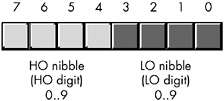2.9 Binary-Coded Decimal (BCD) Representation
2.9 Binary-Coded Decimal (BCD) Representation
The binary-coded decimal (BCD) format, as its name suggests, encodes decimal values using a binary representation. The 80x86 CPU family provides several machine instructions that convert between BCD and pure binary formats. Common general-purpose high-level languages (like C/C++, Pascal, and Java) rarely support decimal values. However, business-oriented programming languages (like COBOL and many database languages) support this data type. So if you're writing code that interfaces with a database or some language that supports decimal arithmetic, you may need to deal with BCD representation.
BCD values consist of a sequence of nibbles , with each nibble representing a value in the range 0..9. Of course, you can represent values in the range 0..15 using a nibble; the BCD format, however, uses only 10 of the possible 16 values. Each nibble represents a single decimal digit in a BCD value, so with a single byte we can represent values containing two decimal digits (0..99), as shown in Figure 2-8. With a word, we can represent values having four decimal digits (0..9999). Likewise, a double word can represent up to eight decimal digits.

Figure 2-8: BCD data representation in a byte
As you can see, BCD storage isn't particularly efficient. An 8-bit BCD variable can represent values in the range 0..99 while that same eight bits, holding a binary value, could represent values in the range 0..255. Likewise, a 16-bit binary value can represent values in the range 0..65535 while a 16-bit BCD value can only represent about a sixth of those values (0..9999). Inefficient storage isn't the only problem with BCD, though. BCD calculations also tend to be slower than binary calculations.
At this point, you're probably wondering why anyone would ever use the BCD format. The BCD format does have two saving graces: it's very easy to convert BCD values between the internal numeric representation and their decimal string representations, and it's also very easy to encode multidigit decimal values in hardware when using BCD - for example, when using a set of dials with each dial representing a single digit. For these reasons, you're likely to see people using BCD in embedded systems (such as toaster ovens and alarm clocks) but rarely in general-purpose computer software.
A few decades ago people mistakenly thought that calculations involving BCD (or just decimal) arithmetic were more accurate than binary calculations. Therefore, they would often perform important calculations, like those involving dollars and cents (or other monetary units) using decimal-based arithmetic. While it is true that certain calculations can produce more accurate results in BCD, this statement is not true in general. Indeed, for most calculations the binary representation is more accurate. For this reason, most modern computer programs represent all values (including decimal values) in a binary form. For example, the Intel 80x86 floating-point unit (FPU) supports a pair of instructions for loading and storing BCD values. Internally, however, the FPU converts these BCD values to binary. It only uses BCD as an external data format (external to the FPU, that is). This generally produces more accurate results.
EAN: 2147483647
Pages: 144